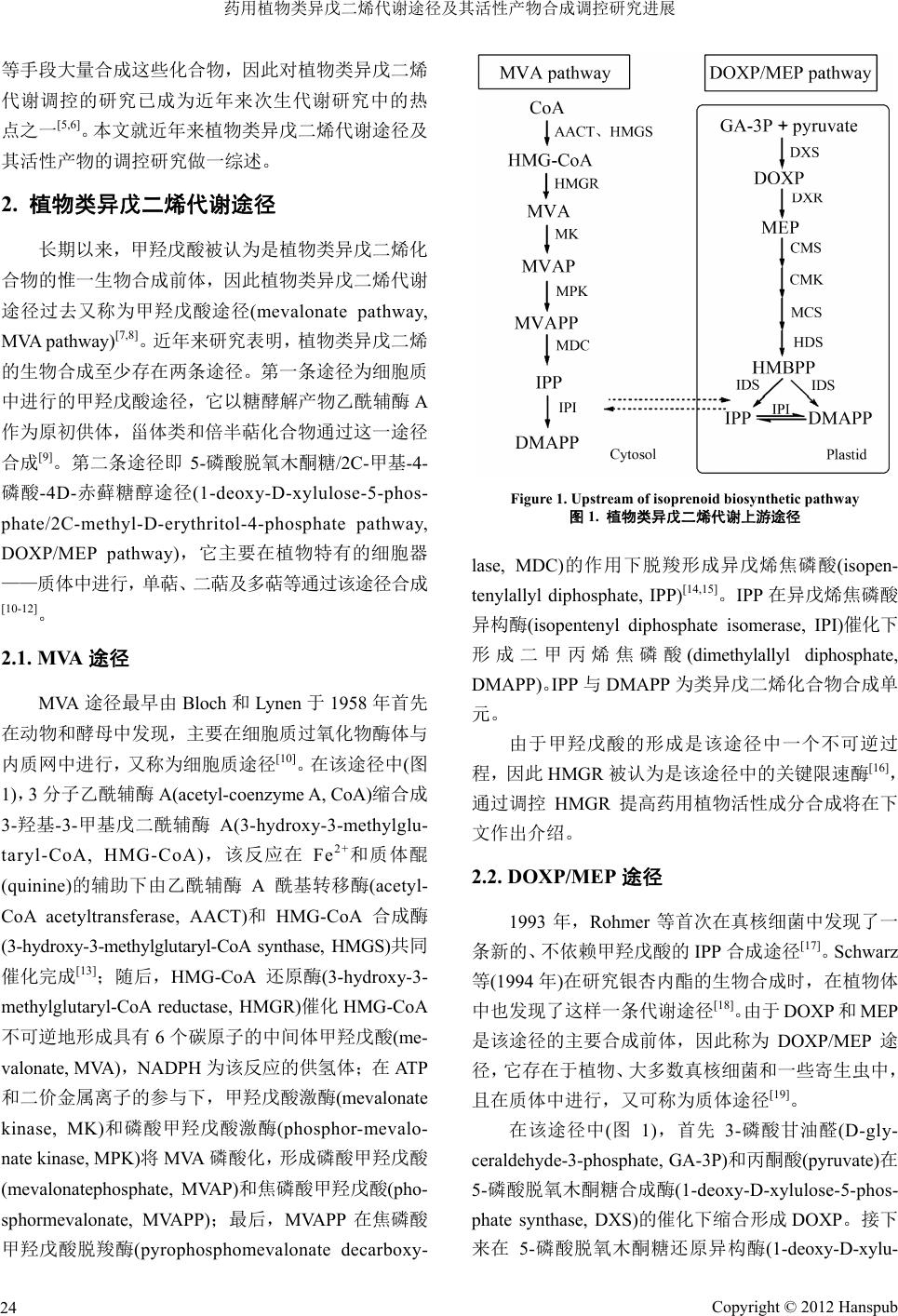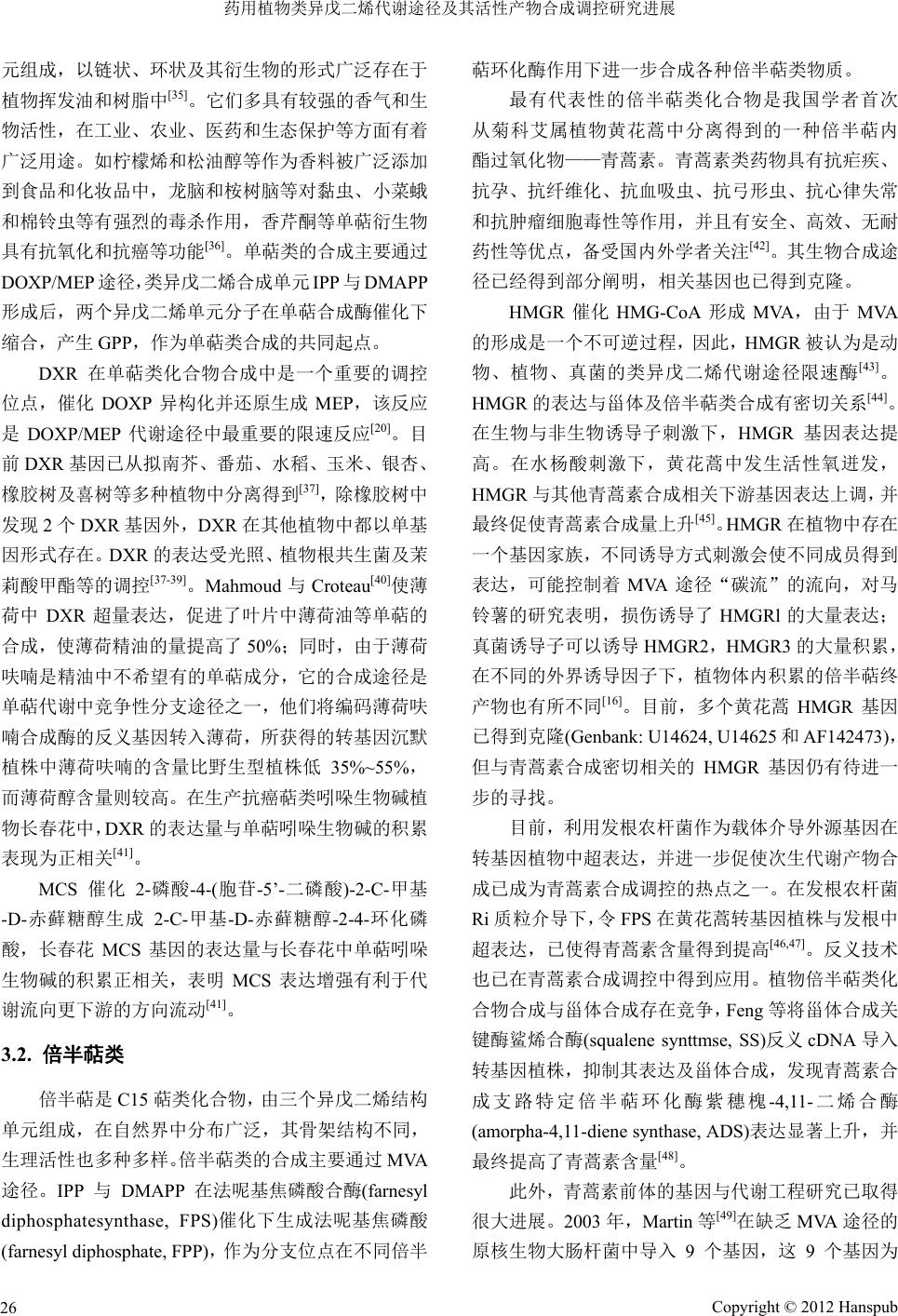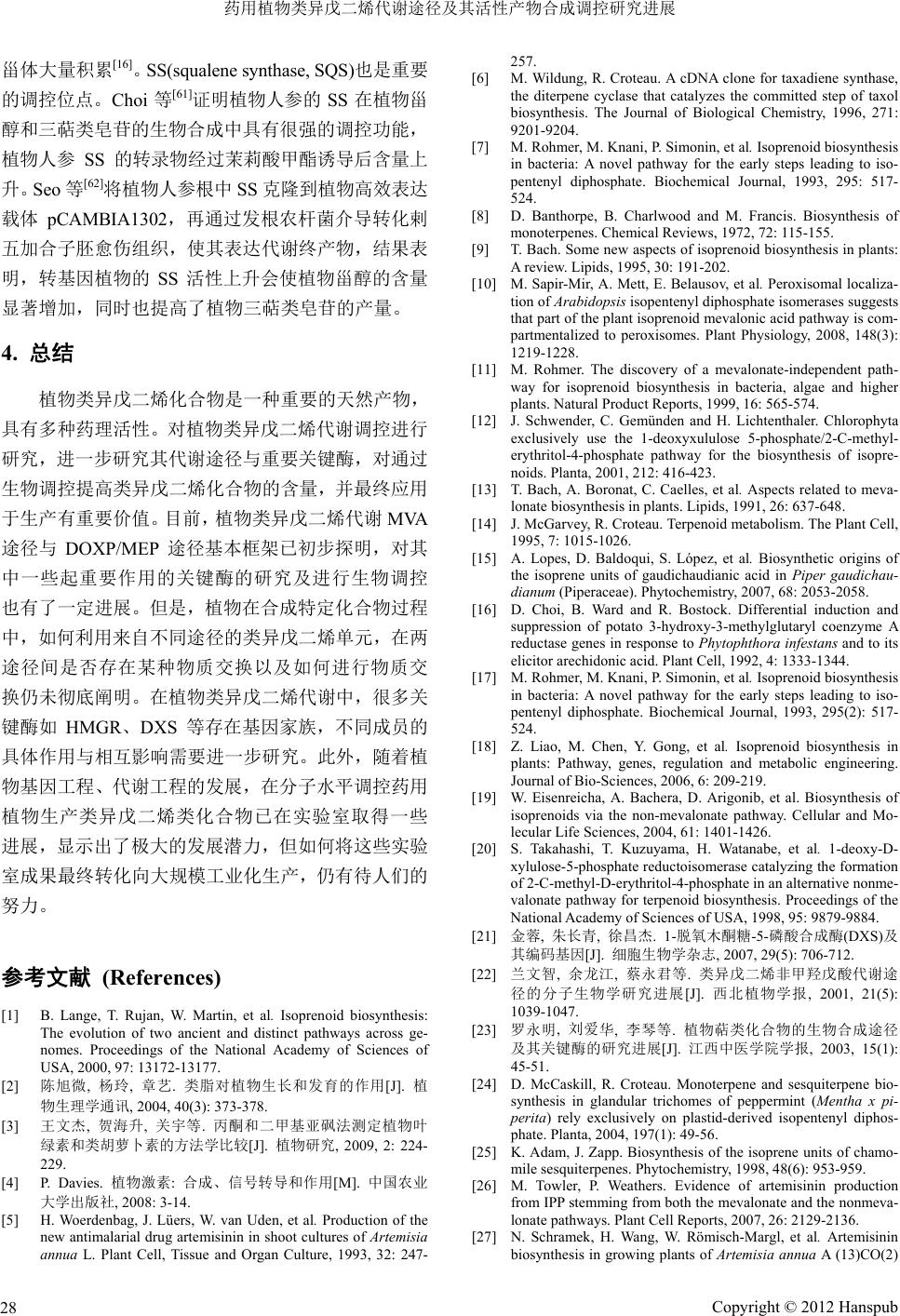 Botanical Research 植物学研究, 2012, 1, 23-29 http://dx.doi.org/10.12677/br.2012.12004 Published Online July 2012 (http://www.hanspub.org/journal/br) Recent Research on Isoprenoid Biosynthetic Pathway and Metabolic Regulation of Functional Isoprenoids in Medicinal Plants* Qiujun Wang, Ben Zhang, Jianwen Wang# College of Pharmaceutical Sciences, Soochow University, Suzhou Email: #jwwang@suda.edu.cn Received: May 2nd, 2012; revised: May 25th, 2012; accepted: Jun. 3rd, 2012 Abstract: Isoprenoids originally from medicinal plants are natural products of diverse bioactivities. Isopre- noids were synthesized in plants via the mevalonate (MVA) pathway and the 2-C-methyl-D-erythritol-4- phosphate (MEP) pathway whose regulation mechanisms are research hotspots in recent years. This article gives a summary of recent explorations on isoprenoid biosynthetic pathway and metabolic regulation of func- tional isoprenoids in medicinal plan ts. Keywords: Isoprenoids; Biosynthesis; Mevalonate (MVA) Pathway; 2-C-Methyl-D-Erythritol-4-Phosphate Pathway (MEP) 药用植物类异戊二烯代谢途径及其活性产物 合成调控研究进展* 王秋军,张 犇,王剑文# 苏州大学药学院,苏州 Email: #jwwang@suda.edu.cn 收稿日期:2012 年5月2日;修回日期:2012 年5月25 日;录用日期:2012 年6月3日 摘 要:植物类异戊二烯化合物是一类具有多种药理活性的天然产物,其生物合成主要通过甲羟戊酸 途径与 2C-甲基-4-磷酸-4D-赤藓糖醇途径,对这两条途径的调控研究已成为近年来热点之一。本文就 近年来植物类异戊二烯代谢途径的研究进展以及相关活性成分的生物合成调控研究做一综述。 关键词:类异戊二烯化合物;生物合成;甲羟戊酸途径;2C-甲基 4-磷酸-4D-赤藓糖醇途径 1. 引言 植物类异戊二烯是以异戊二烯为基本单元构建 的一类化合物,该类化合物在自然界分布广泛、种类 繁多,迄今已发现了近三万多种该类化合物[1]。植物 类异戊二烯包括单萜、倍半萜、二萜、三萜、多萜及 甾体等,在植物体内发挥重要的生理功能,固醇是植 物细胞生物膜的主要组成成分[2];叶绿素和类胡萝卜 素是重要的光合色素[3];植物激素是调控植物生长、 发育的重要物质,在调节植物与环境之间的关系尤其 是调节植物抗性上也起着重要的作用[4]。许多药用植 物活性类异戊二烯化合物在人类抗肿瘤与抗疟等临 床应用上具有很高价值。研究者尝试了解植物类异戊 二烯化合物生物合成途径,利用代谢工程和基因工程 *资助信息:国家教育部留学基金项目(K513201011),苏州大学东 吴学者计划(14317363)和江苏省六大人才高峰项目(Bu132802)。 #通讯作者。 Copyright © 2012 Hanspub 23  药用植物类异戊二烯代谢途径及其活性产物合成调控研究进展 等手段大量合成这些化合物,因此对植物类异戊二烯 代谢调控的研究已成为近年来次生代谢研究中的热 点之一[5,6]。本文就近年来植物类异戊二烯代谢途径及 其活性产物的调控研究做一综述。 2. 植物类异戊二烯代谢途径 长期以来,甲羟戊酸被认为是植物类异戊二烯化 合物的惟一生物合成前体,因此植物类异戊二烯代谢 途径过去又称为甲羟戊酸途径(mevalonate pathway, MVA pathway)[7,8]。近年来研究表明,植物类异戊二烯 的生物合成至少存在两条途径。第一条途径为细胞质 中进行的甲羟戊酸途径,它以糖酵解产物乙酰辅酶 A 作为原初供体,甾体类和倍半萜化合物通过这一途径 合成[9]。第二条途径即 5-磷酸脱氧木酮糖/2C-甲基-4- 磷酸-4D-赤藓糖醇途径(1-deoxy-D-xylulose-5-phos- phate/2C-methyl-D-erythritol-4-phosphate pathway, DOXP/MEP pathway),它主要在植物特有的细胞器 ——质体中进行,单萜、二萜及多萜等通过该途径合成 [10-12]。 2.1. MVA途径 MVA途径最早由 Bloch 和Lynen于1958 年首先 在动物和酵母中发现,主要在细胞质过氧化物酶体与 内质网中进行,又称为细胞质途径[10]。在该途径中(图 1),3分子乙酰辅酶 A(acetyl-coenzyme A, CoA) 缩合成 3-羟基-3-甲基戊二酰辅酶 A(3-hydroxy-3-methylglu- taryl-CoA, HMG-CoA),该反应在 Fe2+和质体醌 (quinine)的辅助下由乙酰辅酶 A酰基转移酶(acetyl- CoA acetyltransferase, AACT)和HMG-CoA 合成酶 (3-hydroxy-3-methylglutaryl-CoA synthase, HMGS)共同 催化完成[13];随后,HMG-CoA 还原酶(3-hydroxy-3- methylglutaryl-CoA reductase, HMGR)催化 HMG-CoA 不可逆地形成具有 6个碳原子的中间体甲羟戊酸(me- valonate, MVA),NADPH 为该反应的供氢体;在 ATP 和二价金属离子的参与下,甲羟戊酸激酶(mevalonate kinase, MK)和磷酸甲羟戊酸激酶(phosphor-mevalo- nate kinase, MPK)将MVA磷酸化,形成磷酸甲羟戊酸 (mevalonatephosphate, MVAP)和焦磷酸甲羟戊酸(pho- sphormevalonate, MVAPP);最后,MVAPP 在焦磷酸 甲羟戊酸脱羧酶(pyrophosphomevalonate decarboxy- Figure 1. Upstream of isoprenoid biosynthetic pathway 图1. 植物类异戊二烯代谢上游途径 lase, MDC)的作用下脱羧形成异戊烯焦磷酸(isopen- tenylallyl diphosphate, IPP)[14,15]。IPP 在异戊烯焦磷酸 异构酶(isopentenyl diphosphate isomerase, IPI)催化下 形成二甲丙烯焦磷酸(dimethylallyl diphosphate, DMAPP)。IPP 与DMAPP 为类异戊二烯化合物合成单 元。 由于甲羟戊酸的形成是该途径中一个不可逆过 程,因此 HMGR 被认为是该途径中的关键限速酶[16], 通过调控 HMGR 提高药用植物活性成分合成将在下 文作出介绍。 2.2. DOXP/MEP途径 1993 年,Rohmer 等首次在真核细菌中发现了一 条新的、不依赖甲羟戊酸的 IPP合成途径[17]。Schwarz 等(1994 年)在研究银杏内酯的生物合成时,在植物体 中也发现了这样一条代谢途径[18]。由于 DOXP 和MEP 是该途径的主要合成前体,因此称为DOXP/MEP途 径,它存在于植物、大多数真核细菌和一些寄生虫中, 且在质体中进行,又可称为质体途径[19]。 在该途径中(图1),首先3-磷酸甘油醛(D-gly- ceraldehyde-3-phosphate, GA-3P)和丙酮酸(pyruvate)在 5-磷酸脱氧木酮糖合成酶(1-deoxy-D-xylulose-5-phos- phate synthase, DXS)的催化下缩合形成 DOXP。接下 来在 5-磷酸脱氧木酮糖还原异构酶(1-deoxy-D-xylu- Copyright © 2012 Hanspub 24  药用植物类异戊二烯代谢途径及其活性产物合成调控研究进展 lose-5-phosphate reductoisomerase, DXR)催化下,DOXP 发生分子内重排和还原反应,生成 MEP。随后,MEP 在4-磷酸-2 C-甲基赤藓糖醇-4-胞苷焦磷酸合成酶(4- diphosphocytidyl-2C-methyl-D-erythritol-4-phosphate syn- thase, CMS)、2C-甲基赤藓糖醇-4-胞苷焦磷酸激酶(4- diphosphocytidyl -2C-met hyl-D-erythrit ol kinase, C MK)、 2C-甲基赤藓糖醇-2,4-焦磷酸合成酶(2C-methyl-D- erythritol 2, 4-diphosphate synthase, MCS)、1-羟基-2-甲 基-2-丁烯-4-焦磷酸合成酶(1-hydroxy-2-methyl-bu- tenyl-4-diphosphate synthase, HDS)等一系列酶的催化 下形成 1-羟基-2-甲基-2-丁烯-4-焦磷酸(1-hydroxy-2- methyl-2-(E)-butenyl-4-diphosphate, HMBPP),HMBPP 在IPP/DMAPP 合成酶(IPP/DMAPP synthase, IDS)催 化下最终形成 IPP 和DMAPP[20]。DXS 与DXR 为 DOXP/MEP 途径中调控类异戊二烯代谢的重要位点 [21]。 2.3. 下游反应 通过以上两种途径,IPP得到合成,但由于它自 身不能离子化,需要在 IPI催化下转化为具有活性的 异构体 DMAPP[22]。接下来在异戊烯转移酶(prenyl- transferase, PTS)的催化下,IPP 和DMAPP 以“头– 尾”或“头–头”相接的方式缩合成牻牛儿基焦磷酸 (geranyl pyro phos phate, GPP);GPP 再与第二个、第三 个IPP 缩合成法呢基焦磷酸(farnesyl pyrophosphate, FPP)和牻牛儿基牻牛儿基焦磷酸(geranylgeranylpyro- phosph ate, GGPP)。GPP、FPP 和GGPP 这3种中间体 分别由相应的萜类合成酶催化形成高级的类异戊二 烯化合物(图2)[23]。 2.4. MVA途径与 DOXP/MEP途径间的物质交换 MVA途径与 DOXP/MEP 途径在植物细胞内的定 位虽然不同,但它们并不是完全独立的途径。胡椒薄 荷精油分泌腺的 MVA 途径被阻断后,DOXP/MEP途 径可为单萜和倍半萜合成提供 IPP[24]。在甘菊中进行 的倍半萜标记试验以及 13C-核磁共振波谱定量研究表 明两种异戊二烯构建单元主要来自 DOXP/MEP 途径, 其中约 l/3 共同来自MVA 和DOXP/MEP 途径[25]。 Towler 分别阻断黄花蒿中 MVA与DOXP/MEP 途径, 发现倍半萜产物青蒿素含量都会受到影响,提示青蒿 素合成同样可能从两个途径获得所需 IPP[26]。Schra- Figure 2. Downstream of isoprenoid biosynthetic pathway 图2. 植物类异戊二烯下游途径 mek 等通过放射性同位素标记研究进一步证实青蒿素 合成所需类异戊二烯单元分别来自不同途径[27]。通 过 高通量基因芯片分析表明,萜类前体物质 IPP 可以在 细胞质和质体之间穿梭,从而将在亚细胞空间上隔离 的MVA 途径和 DOXP/MEP 途径联系起来,并且该转 运系统是由 Ca2+控制开启和关闭的[28],无方向性的质 子转运体系也为两条途径代谢中间产物存在的交换 现象提供了直接证据[29]。以上这些研究提示两途径之 间可能存在中间产物的交叉转换,但两途径间哪些中 间物质参与交换,植物对这种物质交换如何进行调控 仍有待进一步研究。同时也存在报道,阻断其中一条 代谢途径后,拟南芥中的正常类异戊二烯化合物合成 所需原料并不能够单纯通过另一途径提供的中间产 物得到补偿[30,31]。此外,在DOXP/MEP 途径中,关 键酶 DXR 活性受到竞争性抑制剂磷胺霉素抑制后, 植物会通过升高 DXS与DXR 表达水平进行弥补[32], 同时有证据表明质体基因编码的蛋白对该途径类异 戊二烯化合物合成起到调控作用[33]。Flores-Perez等[34] 进一步研究确定质体编码的 CLP 蛋白酶活性与 DOXP/MEP 途径酶水平存在负相关。这些研究提示在 各代谢途径中可能存在更复杂的调控机制。 3. 药用植物类异戊二烯活性成分的 生物合成调控 3.1. 单萜类 单萜是 C10萜类化合物,由两个异戊二烯结构单 Copyright © 2012 Hanspub 25  药用植物类异戊二烯代谢途径及其活性产物合成调控研究进展 元组成,以链状、环状及其衍生物的形式广泛存在于 植物挥发油和树脂中[35]。它们多具有较强的香气和生 物活性,在工业、农业、医药和生态保护等方面有着 广泛用途。如柠檬烯和松油醇等作为香料被广泛添加 到食品和化妆品中,龙脑和桉树脑等对黏虫、小菜蛾 和棉铃虫等有强烈的毒杀作用,香芹酮等单萜衍生物 具有抗氧化和抗癌等功能[36]。单萜类的合成主要通过 DOXP/MEP 途径,类异戊二烯合成单元 IPP 与DMAPP 形成后,两个异戊二烯单元分子在单萜合成酶催化下 缩合,产生 GPP,作为单萜类合成的共同起点。 DXR 在单萜类化合物合成中是一个重要的调控 位点,催化 DOXP 异构化并还原生成 MEP,该反应 是DOXP/MEP 代谢途径中最重要的限速反应[20]。目 前DXR 基因已从拟南芥、番茄、水稻、玉米、银杏、 橡胶树及喜树等多种植物中分离得到[37],除橡胶树中 发现 2个DXR 基因外,DXR 在其他植物中都以单基 因形式存在。DXR 的表达受光照、植物根共生菌及茉 莉酸甲酯等的调控[37-39]。Mahmoud 与Croteau[40]使薄 荷中 DXR 超量表达,促进了叶片中薄荷油等单萜的 合成,使薄荷精油的量提高了 50%;同时,由于薄荷 呋喃是精油中不希望有的单萜成分,它的合成途径是 单萜代谢中竞争性分支途径之一,他们将编码薄荷呋 喃合成酶的反义基因转入薄荷,所获得的转基因沉默 植株中薄荷呋喃的含量比野生型植株低 35%~55%, 而薄荷醇含量则较高。在生产抗癌萜类吲哚生物碱植 物长春花中,DXR 的表达量与单萜吲哚生物碱的积累 表现为正相关[41]。 MCS 催化2-磷酸-4-(胞苷-5’-二磷酸)-2-C-甲基 -D-赤藓糖醇生成2-C- 甲基-D-赤藓糖醇-2-4-环化磷 酸,长春花 MCS 基因的表达量与长春花中单萜吲哚 生物碱的积累正相关,表明 MCS表达增强有利于代 谢流向更下游的方向流动[41]。 3.2. 倍半萜类 倍半萜是 C15 萜类化合物,由三个异戊二烯结构 单元组成,在自然界中分布广泛,其骨架结构不同, 生理活性也多种多样。倍半萜类的合成主要通过MVA 途径。IPP 与DMAPP 在法呢基焦磷酸合酶(farnesyl diphosphatesynthase, FPS)催化下生成法呢基焦磷酸 (farnesyl diphosphate, FPP),作为分支位点在不同倍半 萜环化酶作用下进一步合成各种倍半萜类物质。 最有代表性的倍半萜类化合物是我国学者首次 从菊科艾属植物黄花蒿中分离得到的一种倍半萜内 酯过氧化物——青蒿素。青蒿素类药物具有抗疟疾、 抗孕、抗纤维化、抗血吸虫、抗弓形虫、抗心律失常 和抗肿瘤细胞毒性等作用,并且有安全、高效、无耐 药性等优点,备受国内外学者关注[42]。其生物合成途 径已经得到部分阐明,相关基因也已得到克隆。 HMGR 催化 HMG-CoA 形成 MVA,由于 MVA 的形成是一个不可逆过程,因此,HMGR 被认为是动 物、植物、真菌的类异戊二烯代谢途径限速酶[43]。 HMGR 的表达与甾体及倍半萜类合成有密切关系[44]。 在生物与非生物诱导子刺激下,HMGR 基因表达提 高。在水杨酸刺激下,黄花蒿中发生活性氧迸发, HMGR 与其他青蒿素合成相关下游基因表达上调,并 最终促使青蒿素合成量上升[45]。HMGR 在植物中存在 一个基因家族,不同诱导方式刺激会使不同成员得到 表达,可能控制着MVA途径“碳流”的流向,对马 铃薯的研究表明,损伤诱导了 HMGRl 的大量表达; 真菌诱导子可以诱导 HMGR2,HMGR3 的大量积累, 在不同的外界诱导因子下,植物体内积累的倍半萜终 产物也有所不同[16]。目前,多个黄花蒿HMGR基因 已得到克隆(Genbank: U14624, U14625和AF142473), 但与青蒿素合成密切相关的HMGR 基因仍有待进一 步的寻找。 目前,利用发根农杆菌作为载体介导外源基因在 转基因植物中超表达,并进一步促使次生代谢产物合 成已成为青蒿素合成调控的热点之一。在发根农杆菌 Ri 质粒介导下,令 FPS 在黄花蒿转基因植株与发根中 超表达,已使得青蒿素含量得到提高[46,47]。反义技术 也已在青蒿素合成调控中得到应用。植物倍半萜类化 合物合成与甾体合成存在竞争,Feng 等将甾体合成关 键酶鲨烯合酶(squalene synttmse, SS)反义 cDNA导入 转基因植株,抑制其表达及甾体合成,发现青蒿素合 成支路特定倍半萜环化酶紫穗槐-4,11-二烯合酶 (amorpha-4,11-diene synthase, ADS)表达显著上升,并 最终提高了青蒿素含量[48]。 此外,青蒿素前体的基因与代谢工程研究已取得 很大进展。2003年,Martin 等[49]在缺乏 MVA 途径的 原核生物大肠杆菌中导入 9个基因,这 9个基因为 Copyright © 2012 Hanspub 26  药用植物类异戊二烯代谢途径及其活性产物合成调控研究进展 MVA途径中的编码基因以及青蒿素前体紫穗槐-4, 11-二烯合酶基因,通过在大肠杆菌中重建 MVA 途径 和紫穗槐-4,11-二烯合成途径,使其生产了青蒿素关键 中间产物紫穗槐-4,11-二烯。2006 年,Newman 等[50] 通过优化底物与发酵条件,提高了该大肠杆菌工程菌 的紫穗槐-4,11-二烯产 量。2006年,Ro 等[51]以具 有 MVA途径的真核生物酿酒酵母为 宿主 菌, 导入 了 位 于青蒿素合成下游的紫穗槐-4,11-二烯合酶和紫穗槐 -4,11-二烯合酶 P450单氧合酶基因,重建了青蒿素前 体青蒿酸的代谢途径,通过对培养条件进行优化,获 得了 11.5 mg/L的青蒿酸。 3.3. 二萜类 二萜类是 C20 萜类化合物,由四个异戊二烯单位 构成,不少二萜衍生物如银杏内酯、紫杉醇等有良好 的生物活性。二萜类合成主要通过 DOXP/MEP 途径。 IPP 与DMAPP 形成后,四个异戊二烯单元分子逐一 缩合,产生 GGPP,作为二萜类合成的共同起点。 银杏内酯是从银杏中提取的二萜类物质,与其生 物合成相关的基因已经得到克隆[52]。DXS 是DOXP/ MEP 途径上的第一个酶,它催化 GA-3P 与pyruvate 生成 DOXP,也是该途径中的一个关键酶。在植物中 DXS 同样存在一个基因家族,对不同刺激各成员作出 不同应答[18]。目前已从银杏中分离的DXS 属于植物 DXS1群,而且可能比其他 DXS更古老,外源刺激如 茉莉酸甲酯、花生四烯酸、乙酰水杨酸等可诱导其表 达,并进一步影响银杏内酯合成[20]。 CMK 为DOXP/MEP 途径上的唯一激酶,催化 4-(5’-二磷酸胞苷)-2-C-甲基-D-赤藓醇磷酸化生成 4-(5’-二磷酸胞苷)-2-C-甲基-D-赤藓醇-2-磷酸。CMK 在多种植物中都已得到克隆[53]。唇形科植物丹参根中 脂溶性活性成分主要为二萜醌类化合物丹参酮,其合 成途径中 CMK 已得到克隆,该基因受茉莉酸甲酯诱 导后表达量上升,并进一步促进丹参中丹参酮类的积 累[54]。 紫杉醇是从红豆杉属植物树皮中提取分离出来 的一种重要次生代谢物,由于其具有显著抗癌效果, 现已成为临床上治疗肿瘤的重要药物。紫杉醇三环二 萜骨架通过 DOXP/MEP 途径合成,合成相关基因很 多已经得到克隆[55]。Expósito 等[56]利用不同浓度紫杉 醇刺激红豆杉细胞,发现在添加 200 mg/L外源紫杉醇 时,DXS被诱导表达,同时紫杉醇产量提高,达到对 照组的 32.7 倍。 3.4. 三萜类 三萜类是 C30 萜类化合物,由六个异戊二烯单位 构成,广泛分布于植物界中。三萜皂苷具有抗肿瘤、 抗高胆固醇血症、调节生物体免疫力等活性[57]。三萜 类骨架合成主要通过 MVA 途径,经该途径合成的 FPP 在SS作用下生成鲨烯,然后经鲨烯环氧酶(squalene epoxidase, SE)催化转变为 2,3-氧化鲨烯,并进一步在 特定氧化鲨烯环化酶(oxidosqualene cvclases, OSCs)的 环化作用下得到不同三萜类物质骨架。 药用植物大戟的根中含有三萜类成分大戟甙、生 物碱、大戟素 A、B、C等,具有致泻、利尿、降压 等药理活性[58],曹小迎等[59]从大戟中扩增出 HMGR 基因片段,并利用生物信息学手段对其序列进行了分 析,为通过基因工程手段调控萜类代谢关键酶继而促 进三萜类活性产物积累奠定基础。 三萜皂苷类化合物紫苑酮,为菊科植物紫菀及蹄 叶橐吾(山紫菀)等的主要活性成分。杜鹃[60]以蹄叶橐 吾为材料,克隆了全长及部分HMGR 基因序列(Gen- bank: DQ916 106, EF133501),利用生物信息学手段对 其进行了分析,并成功构建了HMGR 基因的高效表 达载体 pBSHMGR,转化植物使其超表达 HMGR 基 因后,使得转基因根茎中紫苑酮含量比野生型分别增 加了 16.67%和12.25%。 3.5. 甾体 植物甾体广泛存在于不同植物中,包括甾醇、甾 体皂苷及甾体生物碱等,其骨架生物合成主要通过 MVA途径,与三萜类生物合成有 共同 的代 谢途 径 , 两者的分支位于OSCs催化步骤,已从植物中分离鉴 定了四种不同的 OSCs,其中羽扇醇合成酶(lupeol synthase, LS)、香树脂合成酶(-amyrin synthase, -AS)、 达玛烯二醇合成酶(dammarenediol synthase, DS)合成 各类三萜类前体,环阿齐醇合成酶(cycloartenol syn- thase, CAS)合成甾体类前体环阿屯醇[61]。 在甾体合成中HMGR 是关键的限速酶之一,如 伤害诱导可通过提高 HMGR1 转录水平促使马铃薯中 Copyright © 2012 Hanspub 27  药用植物类异戊二烯代谢途径及其活性产物合成调控研究进展 甾体大量积累[16]。SS(squalene synthase, SQS)也是重要 的调控位点。Choi 等[61]证明植物人参的 SS 在植物甾 醇和三萜类皂苷的生物合成中具有很强的调控功能, 植物人参 SS 的转录物经过茉莉酸甲酯诱导后含量上 升。Seo等[62]将植物人参根中 SS克隆到植物高效表达 载体 pCAMBIA1302,再通过发根农杆菌介导转化剌 五加合子胚愈伤组织,使其表达代谢终产物,结果表 明,转基因植物的 SS 活性上升会使植物甾醇的含量 显著增加,同时也提高了植物三萜类皂苷的产量。 4. 总结 植物类异戊二烯化合物是一种重要的天然产物, 具有多种药理活性。对植物类异戊二烯代谢调控进行 研究,进一步研究其代谢途径与重要关键酶,对通过 生物调控提高类异戊二烯化合物的含量,并最终应用 于生产有重要价值。目前,植物类异戊二烯代谢 MVA 途径与 DOXP/MEP途径基本框架已初步探明,对其 中一些起重要作用的关键酶的研究及进行生物调控 也有了一定进展。但是,植物在合成特定化合物过程 中,如何利用来自不同途径的类异戊二烯单元,在两 途径间是否存在某种物质交换以及如何进行物质交 换仍未彻底阐明。在植物类异戊二烯代谢中,很多关 键酶如 HMGR、DXS等存在基因家族,不同成员的 具体作用与相互影响需要进一步研究。此外,随着植 物基因工程、代谢工程的发展,在分子水平调控药用 植物生产类异戊二烯类化合物已在实验室取得一些 进展,显示出了极大的发展潜力,但如何将这些实验 室成果最终转化向大规模工业化生产,仍有待人们的 努力。 参考文献 (References) [1] B. Lange, T. Rujan, W. Martin, et al. Isoprenoid biosynthesis: The evolution of two ancient and distinct pathways across ge- nomes. Proceedings of the National Academy of Sciences of USA, 2000, 97: 13172-1 3177. [2] 陈旭微, 杨玲, 章艺. 类脂对植物生长和发育的作用[J]. 植 物生理学通讯, 2004, 40(3): 373-378. [3] 王文杰, 贺海升, 关宇等. 丙酮和二甲基亚砜法测定植物叶 绿素和类胡萝卜素的方法学比较[J]. 植物研究, 2009, 2: 224- 229. [4] P. Davies. 植物激素: 合成、信号转导和作用[M]. 中国农业 大学出版社, 2008: 3-14. [5] H. Woerdenbag, J. Lüers, W. van Uden, et al. Production of the new antimalarial drug artemisinin in shoot cultures of Artemisia annua L. Plant Cell, Tissue and Organ Culture, 1993, 32: 247- 257. [6] M. Wildung, R. Croteau. A cDNA clone for taxadiene synthase, the diterpene cyclase that catalyzes the committed step of taxol biosynthesis. The Journal of Biological Chemistry, 1996, 271: 9201-9204. [7] M. Rohmer, M. Knani, P. Simonin, et al. Isoprenoid biosynthesis in bacteria: A novel pathway for the early steps leading to iso- pentenyl diphosphate. Biochemical Journal, 1993, 295: 517- 524. [8] D. Banthorpe, B. Charlwood and M. Francis. Biosynthesis of monoterpenes . Chemical Reviews, 1972, 72: 115-155. [9] T. Bach. Some new aspects of isoprenoid biosynthesis in plants: A review. Lipids, 1995, 30: 191-20 2 . [10] M. Sapir-Mir, A. Mett, E. Belausov, et al. Peroxisomal localiza- tion of Arabidopsis isopentenyl diphosphate isomerases suggests that part of the plant isoprenoid mevalonic acid pathway is com- partmentalized to peroxisomes. Plant Physiology, 2008, 148(3): 1219-1228. [11] M. Rohmer. The discovery of a mevalonate-independent path- way for isoprenoid biosynthesis in bacteria, algae and higher plants. Natural P roduct Reports, 1999 , 16: 565-574. [12] J. Schwender, C. Gemünden and H. Lichtenthaler. Chlorophyta exclusively use the 1-deoxyxululose 5-phosphate/2-C-methyl- erythritol-4-phosphate pathway for the biosynthesis of isopre- noids. Planta, 2001, 212: 416-423. [13] T. Bach, A. Boronat, C. Caelles, et al. Aspects related to meva- lonate biosynthesis in plants. Lipids, 1991, 26: 637-648. [14] J. McGarvey, R. Croteau. Terpenoid metabolism. The Plant Cell, 1995, 7: 1015-1026. [15] A. Lopes, D. Baldoqui, S. López, et al. Biosynthetic origins of the isoprene units of gaudichaudianic acid in Piper gaudichau- dianum (Piperaceae). Phytochemistry, 2007, 68: 2053-2058. [16] D. Choi, B. Ward and R. Bostock. Differential induction and suppression of potato 3-hydroxy-3-methylglutaryl coenzyme A reductase genes in response to Phytophthora infestans and to its elicitor arechidonic acid. Plant Cell, 1992, 4: 1333-1344. [17] M. Rohmer, M. Knani, P. Simonin, et al. Isoprenoid biosynthesis in bacteria: A novel pathway for the early steps leading to iso- pentenyl diphosphate. Biochemical Journal, 1993, 295(2): 517- 524. [18] Z. Liao, M. Chen, Y. Gong, et al. Isoprenoid biosynthesis in plants: Pathway, genes, regulation and metabolic engineering. Journal of Bio-Scie nces, 2006, 6: 209-2 1 9. [19] W. Eisenreicha, A. Bachera, D. Arigonib, et al. Biosynthesis of isoprenoids via the non-mevalonate pathway. Cellular and Mo- lecular Life Sciences, 2004, 61: 1401-1426. [20] S. Takahashi, T. Kuzuyama, H. Watanabe, et al. 1-deoxy-D- xylulose-5-phosphate reductoisomerase catalyzing the formation of 2-C-methyl-D-erythritol-4- p hosphate in an alternative nonme- valonate pathway for terpenoid biosynthesis. Proceedings of the National Academy of Sciences of USA, 199 8, 95: 9879-9884. [21] 金蓉, 朱长青, 徐昌杰. 1-脱氧木酮糖-5-磷酸合成酶(DXS)及 其编码基因[J]. 细胞生物学杂志, 2007, 29(5): 706-712. [22] 兰文智, 余龙江, 蔡永君等. 类异戊二烯非甲羟戊酸代谢途 径的分子生物学研究进展[J]. 西北植物学报, 2001, 21(5): 1039-1047. [23] 罗永明, 刘爱华, 李琴等. 植物萜类化合物的生物合成途径 及其关键酶的研究进展[J]. 江西中医学院学报, 2003, 15(1): 45-51. [24] D. McCaskill, R. Croteau. Monoterpene and sesquiterpene bio- synthesis in glandular trichomes of peppermint (Mentha x pi- perita) rely exclusively on plastid-derived isopentenyl diphos- phate. Planta, 2004 , 197(1): 49-56. [25] K. Adam, J. Zapp. Biosynthesis of the isoprene units of chamo- mile sesquiterpenes. Ph ytochemistry, 1998, 48(6): 953-959. [26] M. Towler, P. Weathers. Evidence of artemisinin production from IPP stemming from both the mevalonate and the nonmeva- lonate pathways. Plant Cell Reports, 2007, 26: 2129-2136. [27] N. Schramek, H. Wang, W. Römisch-Margl, et al. Artemisinin biosynthesis in growing plants of Artemisia annua A (13)CO(2) Copyright © 2012 Hanspub 28  药用植物类异戊二烯代谢途径及其活性产物合成调控研究进展 Copyright © 2012 Hanspub 29 study. Phytochemistry, 2010 , 71: 179-187. [28] O. Laule, A. Furholz, H. Chang, et al. Crosstalk between cytoso- lic and plastidial pathways of isopreneoid biosynthesis in Arabi- dopsis thaliana. Proceedings of the National Academy of Sci- ences of USA, 2003, 100 (11): 6866-6871. [29] J. Bick, B. Lange. Metabolic crosstalk between cytosolic and plastidial pathways of isopreneoid biosynthesis: Unidirectional transports of interm ediates across the chloroplast envelope mem- brane. Archives of Biochemistry and Biophysics, 2003, 415(2): 146-154. [30] M. Gutierrez-Nava, C. Gillmor, L. Jimenez, et al. Chloroplast biogenesis genes act cell and noncell autonomously in early chloroplast development. Plant Physiolog y, 2004, 135: 471-482. [31] M. Rodrıguez-Concepcion, O. Fores, J. Martınez-Garcıa, et al. Distinct light-mediated pathways regulate the biosynthesis and exchange of isoprenoid precursors during Arabidopsis seedling development. Plant Cell, 2004, 16: 144 -156. [32] L. Carretero-Paulet, A. Cairo, P. Botella-Pavia, et al. Enhanced flux through the methylerythritol 4-phosphate pathway in Ara- bidopsis plants overexpressing deoxyxylulose 5-phosphate re- ductoisomerase. Plant Molecular Biology, 2006, 62: 683-695. [33] S. Sauret-Gueto, P. Botella-Pavia, U. Flores-Perez, et al. Plastid cues posttranscriptionally regulate the accumulation of key en- zymes of the methylerythritol phosphate pathway in Arabidopsis. Plant Physiology, 2006, 141: 75-84. [34] U. Flores-Perez, S. Sauret-Gueto, E. Gas, et al. A mutant im- paired in the production of plastome-encoded proteins uncovers a mechanism for the homeostasis of isoprenoid biosynthetic en- zymes in arabidopsis plastids. Plant Cell, 2008, 20: 1303-1315. [35] J. B ohlmann, D. Martin, N. Oldham, et a1 . Terpenoid secondary metabolism in Arabidopsis thaliana: cDNA cloning, characteri- zation and functional expression of a myrcene/(E)-13-ocimene synthase. Archives of Bioche mistry an d Biophysics, 2000 , 375(2): 261-269. [36] 徐应文, 吕季娟, 吴卫等. 植物单萜合酶研究进展[J]. 生态 学报, 2009, 29(6): 3188-3197. [37] H. Yao, Y. Gong, K. Zuo, et al. Molecular cloning, expression profiling and functional analysis of a DXR gene encoding 1- deoxy-D-xylulose-5-phosphate reductoisomerase from cam pto- theca acuminate. Journal of Plant Physiology, 2008, 165(2): 203- 213. [38] L. Carretero-Paulet, I. Ahumada, N. Cunillera, et al. Expression and molecular analysis of the Arabidopsis DXR gene encoding 1-deoxy-D-xylulose-5-phosphate reductoisomerase, the first com- mitted enzyme of the 2-C-methyl-D-erythritol-4-phosphate path- way. P l an t Ph ysiology, 2002, 129(3): 1581-1591. [39] J. Hans, B. Hause, D. Stack, et al. Cloning, characterization and immunolocalization of a mycorrhiza-inducible 1-deoxy-D-xy- lulose-5-phosphate reductoiso merase in arbuscule containing cells ofmaize. Plant Physiology, 2004, 134(2): 614-624. [40] S. Mahmoud, R. Croteau. Metabolic engineering of essential oil yield and composition in mint by altering expression of deoxy- xylulose phosphate reductoisomerase and menthofuran synthase. Proceedings of the National Academy of Sciences of USA, 2001, 98: 8915-8920. [41] B. Veau, M. Courtois, A. Oudin, et al. Cloning and expression of cDNAs encoding two enzymes of the MEP pathway in Catha- ranthus roseus. Biochimica Biophysica Acta, 2000, 1517: 159- 163. [42] 贺小青, 方鹏飞. 青蒿素及其衍生物的药理作用[J]. 医药导 报, 2006, 25(6): 528- 5 30. [43] J. Chappell, F. Wolf, J. Proulx, et al. Is the reaction catalyzed by 3-hydroxyl-3-methylglutaryl coenzyme A reductase rate-limiting step for isoprenoid biosynthesis in plants? Plant Ph ysiology, 1995, 109: 1337-1343. [44] 王剑文, 邹婷, 张犇. 青蒿素生物合成研究进展[J]. 抗感染 药学, 2009, 6(2): 77-82. [45] G. Pu, D. Ma, J. Chen, et al. Salicylic acid activates artemisinin biosynthesis in Artemisia annua L. Plant Cell Reports, 2009, 28: 1127-1135. [46] D. Chen, J. Chen, H. Ye, et al. Ri-mediated transformation of Artemisia annua with a recombinant farnesyl diphosphate syn- thase gene for artemisinin production. Plant Cell, Tissue and Or- gan Culture, 1999, 57: 157-162. [47] D. Chen, H. Ye, G. Li, et al. Expression of a chimeric farnesyl diphosphate synthase gene in Artemisia annua L. transgen ic p lants via Agrobacterium tumefaciensmediated transformation. Plant Sci- ence, 2000, 155: 179-185. [48] L. Feng, R. Yang, X. Yang, et al. Synergistic re-channeling of mevalonate pathway for enhanced artemisinin p roduction in trans - genic Artemisia annua. Plant Science, 2009, 177: 57-67. [49] V. Martin, D. Pitera, S. Withers, et al. Engineering a mevalonate pathway in Escherich coli for production of terpenoids. Nature Biotechnology, 2003, 21(7): 796-803. [50] J. Newman, J. Marshall, M. Chang, et al. High level production amorpha-4,11-diene in a two-phase partitioning bio reactor of me- tabolically engineered Escherichia coli. Journal of Biotechnol- ogy, 2006, 95(4): 684-691. [51] D. Ro, I. Parad, M. Ouellet, et al. Production of the antimalarial drug precursor artemisinic acid in engineered yeast. Nature, 2006 , 440(7086): 940-943. [52] Y. Gong, Z. Liao, B. Guo, et al. Molecular cloning and expres- sion profile analysis of Ginkgo biloba DXS gene encoding 1- deoxy-D-xylulose-5-phosphate synthase, the first committed en- zyme of the 2-C-methyl-D-erythritol-4-phosphate pathway. Plan- ta Medica, 2006, 72: 32 9 -335. [53] F. Rohdich, J. Wungsintaweekul, W. Eisenreich, et al. Biosyn- thesis of terpenoids: 4-diphosphocytidyl-2-C-methyl-D-erythri- tol synthase of Arabidopsis thaliana. Proceedings of the National Academy of Sciences of US A , 2000, 97: 6451-6456. [54] 王学勇, 崔光红, 黄璐琦等. 丹参 4-(5’-二磷酸胞苷 )-2-C-甲 基-D-赤藓醇激酶的 cDNA 全长克隆及其诱导表达分析[J]. 药学学报, 2008, 43(12): 1251-12 5 7. [55] 郑清平, 余龙江, 刘智等. 红豆杉细胞非甲羟戊酸途径关键 酶基因 dxr的克隆与分析[J]. 生物工程学报, 2004, 4: 548-553. [56] O. Expósito, M. Bonfill, M. Onrubia, et al. Effect of taxol feed- ing on taxol and related taxane production in Taxus baccata su- spension cultures. New Biotechnology, 2009, 25(4): 252-259. [57] H. Suzuki, L. Achnine, R. Xu, et al. Agenomics approach to the early stages of triterpene saponin biosynthesis in Medicago trun- catula. The Plant Journal, 2002, 32(6): 1033-1048. [58] Z. Liao, Q. Tan, Y. R. Chai, et al. Cloning and characterization of the gene encoding HMG-CoA reductase from Taxus media and its functional identification in yeast. Functional Plant Biology, 2004, 31: 73-81. [59] 曹小迎, 蒋继宏, 刘群等. 大戟甲羟戊酸途径关键酶基因 hmgr的克隆与分析[J]. 武汉植物学研究, 2007, 25(2): 123- 126. [60] 杜鹃. 蹄叶橐吾萜类化合物合成相关基因克隆及功能研究 [D]. 吉林大学, 2007. [61] D. Choi, J. Jung, Y. Ha, et al. Analysis of transcripts in methyl jasmonate-treated ginseng hairy roots to identify genes involved in the biosynthesis of ginsenosides and other secondary metabo- lites. Plant Cell Reports, 2005, 23(8): 557-566. [62] J. Seo, J. Jeong, C. Shin, et al. Overexpression of squalene syn- thase in Eleutherococcus senticosus increases phytosterol and triterpene accumulation. Phytochemistry, 20 05, 66(8): 869-877. |